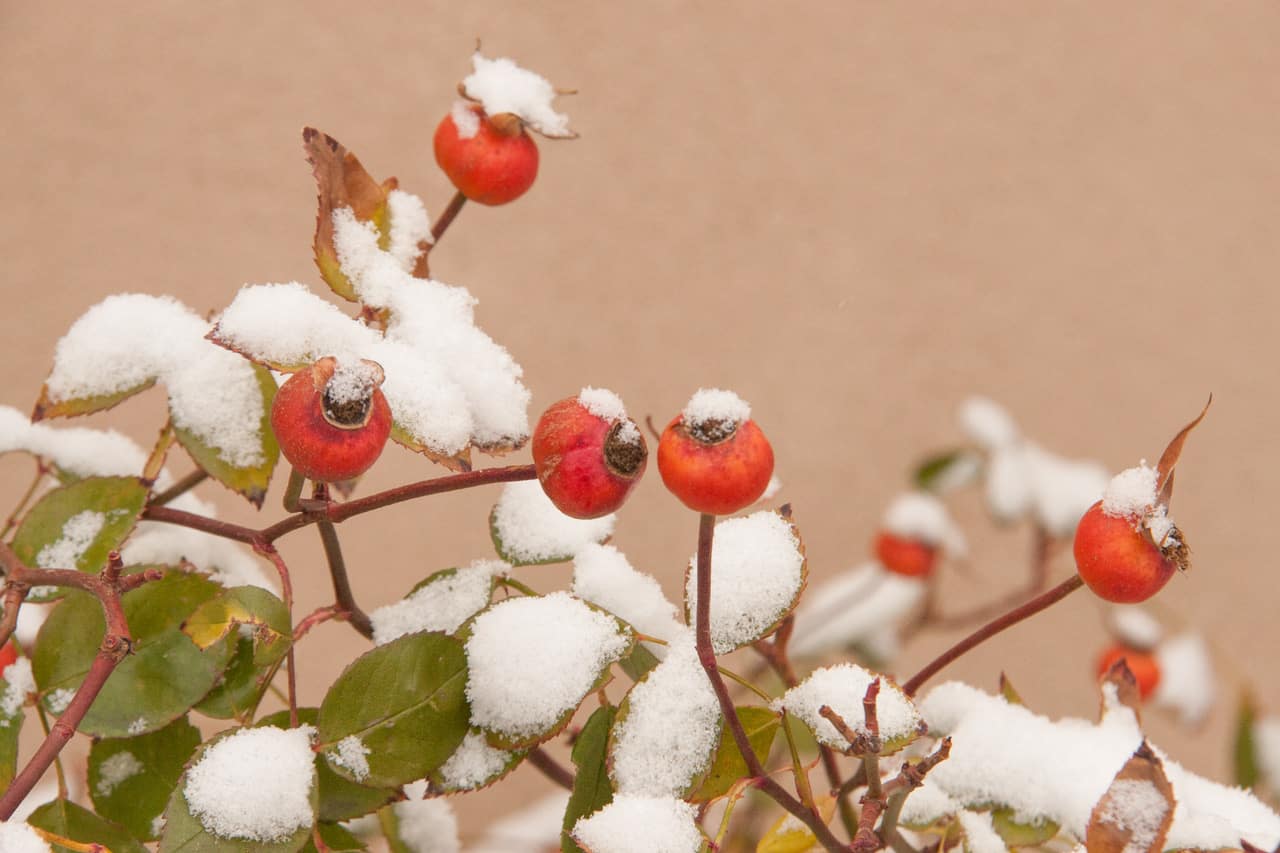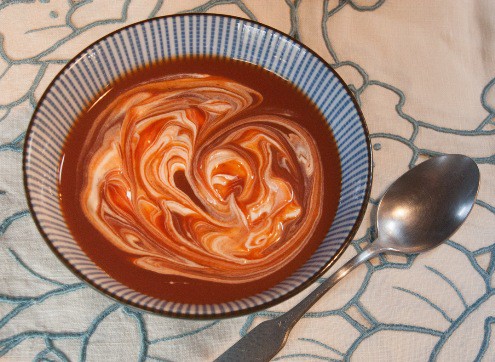
The ground is frozen and covered with snow. But you can still go winter foraging for rosehips, crabapples and wintergreen. In fact, winter can be an exciting and productive time to forage for wild edibles.
My top picks for intrepid winter foragers are rosehips, crabapples and wintergreen. Here’s the information you need about foraging for these wild winter edibles. And scroll down for my delicious recipe for Rose Hip Soup.
Winter Foraging for Rosehips (Rosa species)
All rose hips are edible—providing they haven’t been sprayed with something toxic and are growing in an unpolluted place. Plants near busy roads may absorb heavy metals that leach into the ground from vehicle exhaust. So, it’s better to admire them visually and harvest your edibles from a less-traveled spot.

Rose hips are a persistent fruit. That means they stay on the plant for months, providing excellent nutrition to birds and mammals (including human foragers). That’s why winter foraging for rosehips can be so fruitful.
Rose hip flavor often improves with time. The tastiest hips I ever harvested looked shriveled and dry in April after a snowy winter exposed to the elements. But boy were they delicious!
Rose hips are full of seeds and hairs, which are unpleasant and scratchy in the throat. If you want to work with rose hip pulp (as in this rose hip soup recipe), use bigger hips like those of a rugosa rose bush. Cut them in half and scoop out the seeds and hairs. What’s left is clean rose hip flesh to use in jams, soups and chutneys.
Mulitflora rose is an invasive plant in many parts of the country. Its hips are tiny. But for jelly, syrup, or juice, the size of the hip doesn’t matter. You will be juicing them whole and straining the juice.
Winter Foraging for Crabapples (Malus species)
In addition to winter foraging for rosehips, crabapples are also and excellent wild edible for cold weather collecting. Considering how popular crabapple trees are in the landscape, I’m surprised more people don’t use the fruit. Technically, a crabapple is any apple less than two inches in diameter. Like regular apples, crabapples belong in the genus Malus.

If you harvest crabapples while they’re still plump, try pickling them with cinnamon and nutmeg to serve with pork or turkey. If the fruit is covered with snow and looking a little shriveled, use the juice in cocktails and jelly. You can also use the pulp in applesauce and fruit leather. For a delicious way to use the crabapples you forage, read my story about making Crabapple Whiskey Cake.
Winter Foraging for Wintergreen (Gaultheria procumbens)
Wintergreen is a dainty plant, about three inches tall, with four to six leaves. Each tiny plant has two or three red berries. In summer, its foliage is a glossy dark green. Winter temperatures often give its evergreen leaves a reddish tinge.

Stuff a pint jar full of leaves, then top it off with tepid water. Cover the jar and let it sit for three to five days at room temperature. This releases maximum flavor from the foliage. You’ll want a strong brew to use as a base for wintergreen sorbet, wintergreen ice cream or a rum and wintergreen cocktail.
Wintergreen Warning: Wintergreen contains methyl salicylate, a plant chemical related to the active ingredient in aspirin. If you’re allergic to aspirin, don’t eat wintergreen.
As you can see, there are lots of interesting and delicious plants for winter foraging. The key to successful winter foraging is knowing what to look for. And don’t forget to bundle up before you go winter foraging for rose hips, crabapples and wintergreen!
RECIPE FOR ROSE HIP SOUP
Here’s one of my favorite recipes for winter foraging for rosehips. As you may have guessed, this recipe uses rose hips as the main ingredient. The first step is making rose hip puree. Then you use the puree to make Rose Hip Soup.

Ingredients:
2 cups rose hip purée
2 cups water
1/8 – ¼ cup sugar
1 Tbs. cornstarch
1 Tbs. cold water
cream, yogurt or vanilla ice cream
To make the purée:
Cut each rose hip in half, then scoop out and discard the seeds and hairs. Put the cleaned pulp in a pan and add just enough water to cover the pulp. Cook over low-to-medium heat until the water is fully absorbed, and the pulp has softened. Run the pulp through a food mill to create the purée.
To make the soup:
Combine 2 cups of purée, 2 cups water and 1/8 cup sugar over low heat. Stir to dissolve the sugar. (Taste, and add more sugar if desired.) Remove from the heat.
In a small bowl, combine the cornstarch and 1 Tbs. water to make a paste. Whisk the paste into the rose hip liquid and stir over medium heat until the soup begins to thicken. It’s ok to let it simmer, but stir to avoid scorching.
When the soup has reached the desired thickness, remove it from the heat.
To serve rose hip soup hot, swirl in a little cream or yogurt. To serve it cold, refrigerate and pour over a small scoop of vanilla ice cream.
Enjoy!
————–
Ellen Zachos is the author of The Wildcrafted Cocktail and Backyard Foraging. Her website, BackyardForager.com, is filled with all kinds of great info. Also read Ellen’s Home Garden and Homestead story about making Dandelion Pesto.



Leave a Reply